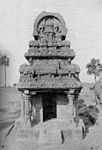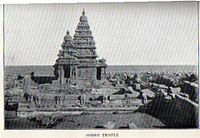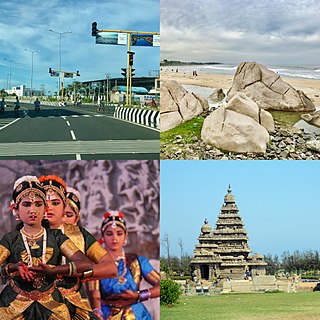
Mahabalipuram, also known as Mamallapuram, is a town in Chengalpattu district in the southeastern Indian state of Tamil Nadu, best known for the UNESCO World Heritage Site of 7th- and 8th-century Hindu Group of Monuments at Mahabalipuram. It is one of the famous tourist sites in India.
Nallathagudi Srinivasa Ramaswami was an Indian sports journalist who worked for four decades with The Hindu, Mail and Indian Express, and became an assistant editor at all three newspapers. He wrote four books on cricket — Winter of Content, Indian Cricket, Indian Willow and From Porbandar to Wadekar — but was also well-versed in history, social commentary and temple architecture.
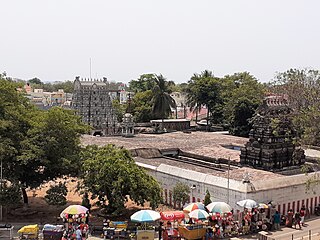
Sthalasayana Perumal Temple is at Mahabalipuram. Constructed in the Dravidian style of architecture, the temple is glorified in the Divya Prabandha, the early medieval Tamil canon of the Azhwar saints from the 6th–9th centuries AD. It is one of the 108 Divyadesam dedicated to Vishnu, who is worshipped as Sthalasayana Perumal and his consort Lakshmi as Nilamangai Thayar. The temple is believed to have been built by Pallavas, with later contributions from Medieval Cholas, Vijayanagar kings and Madurai Nayaks.
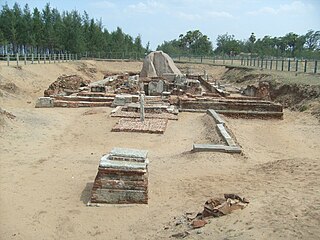
The Murugan Temple at Saluvankuppam, Tamil Nadu, is a shrine dedicated to Tamil deity Murugan. Archaeologists believe that the shrine, unearthed in 2005, consists of two layers: a brick temple constructed during the Sangam period and a granite Pallava temple dating from the 8th century AD and constructed on top of the brick shrine making it the oldest temple in india. The Archaeological Survey of India (ASI) team which conducted the excavation believe that brick temple could be the oldest of its kind to be discovered in Tamil Nadu.

Nearly 33,000 ancient temples, many at least 800 to 2000 years old, are found scattered all over Tamil Nadu. As per Tamil Nadu Hindu Endowments Board, there are 38,615 temples. Most of the largest Hindu Temples reside here. Studded with complex architecture, variety of sculptures, and rich inscriptions, the temples remain the very essence of the culture and heritage of Tamil land, with historical records dating back to at least 3,000 years.
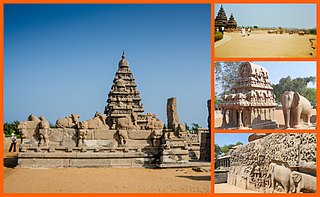
The Group of Monuments at Mahabalipuram is a collection of 7th- and 8th-century CE religious monuments in the coastal resort town of Mahabalipuram, Tamil Nadu, India and a UNESCO World Heritage Site. It is on the Coromandel Coast of the Bay of Bengal, about 60 kilometres (37 mi) south of Chennai.

Pancha Rathas is a monument complex at Mahabalipuram, on the Coromandel Coast of the Bay of Bengal, in the Kancheepuram district of the state of Tamil Nadu, India. Pancha Rathas is an example of monolithic Indian rock-cut architecture. The complex was carved during the reign of King Narasimhavarman I : the idea of realising monolithic buildings, an innovation in Indian architecture, is attributed to this ruler. The complex is under the auspices of the Archaeological Survey of India (ASI) and is part of the UNESCO World Heritage site inscribed by UNESCO as Group of Monuments at Mahabalipuram.

Varaha Cave Temple is a rock-cut cave temple located at Mamallapuram, on the Coromandel Coast of the Bay of Bengal in Kancheepuram District in Tamil Nadu, India. It is part of the hill top village, which is 4 kilometres (2.5 mi) to the north of the main Mahabalipurm sites of rathas and the Shore Temple. It is an example of Indian rock-cut architecture dating from the late 7th century. The temple is one of the finest testimonial to the ancient Hindu rock-cut cave architecture, out of many such caves also called mandapas. Part of the Group of Monuments at Mahabalipuram, the temple is a UNESCO World Heritage Site as inscribed in 1984 under criteria i, ii, iii and iv. The most prominent sculpture in the cave is that of the Hindu god Vishnu in the incarnated form of a Varaha or boar lifting Bhudevi, the mother earth goddess from the sea. Also carved are many mythical figures.
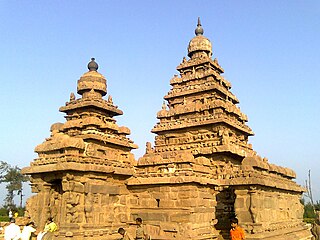
The Shore Temple is so named because it overlooks the shore of the Bay of Bengal. It is located near Chennai in Tamil Nadu, south India.

Dharmaraja Ratha is a monument in the Pancha Rathas complex at Mahabalipuram, on the Coromandel Coast of the Bay of Bengal, in the Kancheepuram district of the state of Tamil Nadu, India. It is an example of monolith Indian rock-cut architecture. Dating from the late 7th century, it is attributed to the reign of King Mahendravarman I and his son Narasimhavarman I of the Pallava Kingdom. The entire complex is under the auspices of the Archaeological Survey of India (ASI). It is one of the Group of Monuments at Mahabalipuram that were designated as a UNESCO World Heritage Site since 1984.

Arjuna Ratha is a monument from the Pallava Period at Mahabalipuram, on the Coromandel Coast of the Bay of Bengal, in Kancheepuram district of Tamil Nadu, India. Dated to the seventh century, it is an example of early Dravidian architecture and of monolith Indian rock-cut architecture dating from the late 7th century during reign of King Mahendravarman I and his son Narasimhavarman I of the Pallava Kingdom. One of the Pancha Rathas, it is believed to have been completed before the Dharmaraja Ratha, and like that and the Bhima Ratha, the stone temple is a replica of an earlier wooden version which preceded it. It is one of the Group of Monuments at Mahabalipuram designated as a UNESCO World Heritage Site since 1984.

Bhima Ratha is a monument in the Pancha Rathas complex at Mahabalipuram, on the Coromandel Coast of the Bay of Bengal, in the Kancheepuram district of the state of Tamil Nadu, India. It is an example of monolith Indian rock-cut architecture. Dating from the late 7th century, it is attributed to the reign of King Mahendravarman I and his son Narasimhavarman I of the Pallava Kingdom. The entire complex is under the auspices of the Archaeological Survey of India (ASI), and is one of the Group of Monuments at Mahabalipuram designated as a UNESCO World Heritage Site since 1984.

The Draupadi Ratha is a monument in the Pancha Rathas complex at Mahabalipuram, previously called Mamallapuram, on the Coromandel Coast of the Bay of Bengal, in the Kancheepuram district of the state of Tamil Nadu, India. It is an example of monolithic Indian rock-cut architecture. Dating from the late 7th century, it is attributed to the reign of King Mahendravarman I and his son Narasimhavarman I of the Pallava Kingdom. The entire complex is under the auspices of the Archaeological Survey of India (ASI), and is one of the Group of Monuments at Mahabalipuram designated as a UNESCO World Heritage Site since 1984.

Nakula Sahadeva Ratha is a monument in the Pancha Rathas complex at Mahabalipuram, on the Coromandel Coast of the Bay of Bengal, in the Kancheepuram district of the state of Tamil Nadu, India. It is an example of monolith Indian rock-cut architecture. Dating from the late 7th century, it is attributed to the reign of King Mahendravarman I and his son Narasimhavarman I of the Pallava Kingdom. The entire complex is under the auspices of the Archaeological Survey of India (ASI), and is one of the Group of Monuments at Mahabalipuram that were designated as a UNESCO World Heritage Site since 1984.

Mahishasuramardhini Mandapa is an example of Indian rock-cut architecture dating from the late 7th century, of the Pallava dynasty. It is a rock-cut cave temple located on a hill, near a lighthouse, along with other caves in Mamallapuram. Mamallapuram, also popularly known as Mahabalipuram, is a small village to the south of Chennai, in the state of Tamil Nadu, India. The temple is part of the Group of Monuments at Mahabalipuram, a UNESCO World Heritage Site inscribed in 1984. This Cave Temple has many interesting architectural features of which three exquisitely carved reliefs on the cave walls of three sanctums are prominent. One is of Vishnu reclining on the seven hooded serpent, Adisesha, another of Durga, the main deity of the cave temple Durga slaying the buffalo headed demon Mahishasura, and the third sanctum also has a sculpture of Shiva.
Enadi Siva Temple is a Hindu temple located at Enadi in the Thirumayam taluk of Pudukkottai district in Tamil Nadu, India. Dedicated to Shiva, the temple dates from the early 10th century AD. The architecture resembles the late Pallava and the roof resembles that of Draupadi Ratha in Mahabalipuram.
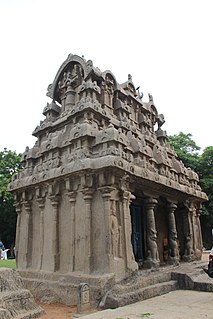
Ganesha Ratha is a temple in Kancheepuram district, Tamil Nadu, India. It is one of ten rathas ("chariots") carved out of pink granite within the group of monuments of the Pallava Period at Mahabalipuram, a UNESCO-inscribed World Heritage Site since 1984. The ratha is an example of monolith Indian rock-cut architecture dating from the late seventh century during the reign of King Mahendravarman I and his son Narasimhavarman I. Initially constructed with a Shiva Linga, it is now deified with a Ganesha deity after the linga was removed.

The Olakkannesvara Temple is in Mahabalipuram town, overlooking the Coromandel Coast of the Bay of Bengal in Kancheepuram District in Tamil Nadu, India. Like the Shore Temple, the Olakkannesvara Temple is a structural temple. Built in the 8th century, it is situated directly above the Mahishasuramardini mandapa on a hillock which provides scenic views of the town. As the area is within a high security zone because of a nuclear power station a few kilometres to its south, photography is prohibited. The Olakkannesvara Temple is sometimes mistakenly referred to as a Mahishasura temple. It is dedicated to an incarnation of Shiva. It is one of the Group of Monuments at Mahabalipuram that were designated as a UNESCO World Heritage Site since 1984.
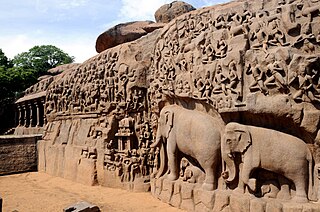
Pallava art and architecture represent an early stage of Dravidian art and architecture which blossomed to its fullest extent under the Chola Dynasty. The first stone and mortar temples of South India were constructed during Pallava rule and were based on earlier brick and timber prototypes.
Kuthur Ramakrishnan Srinivasan (1910–1992) was an Indian archeologist, historian and the author of a number of books on Indian history and culture. He was best known for his archeological work on the Cave Temples of Mahabalipuram. The Government of India awarded him the Padma Bhushan, the third highest civilian award, in 1991.
